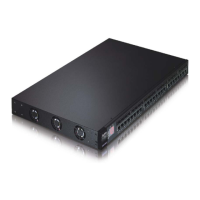
Do you have a question about the ZyXEL Communications XGS-4526 and is the answer not in the manual?
| Brand | ZyXEL Communications |
|---|---|
| Model | XGS-4526 |
| Category | Switch |
| Language | English |
Information on how to get additional support and resources for the switch.
Explains the conventions used for text, keys, and screen names within the guide.
Provides an overview of the switch's features, capabilities, and management options.
Outlines the different methods available for managing and configuring the switch.
Offers best practices for secure and effective switch management to prevent issues.
Details the steps for placing the switch on a flat surface and attaching rubber feet for stability.
Provides instructions and precautions for securely installing the switch into a standard equipment rack.
Describes the ports and indicators located on the front panel of the switch for network connectivity.
Explains the function and installation of SFP transceivers for fiber-optic connections.
Details the components and connectors found on the rear panel of the switch, including power and management ports.
Covers the procedures for connecting the switch to AC or DC power sources, including safety notes.
Explains the meaning of various LEDs on the switch for status monitoring and troubleshooting.
Introduces the HTML-based web configurator for easy switch setup and management via a web browser.
Guides users on how to access the web configurator by entering the switch's IP address in a browser.
Provides an overview of the web configurator's interface, including navigation components and quick links.
Explains how to save changes to run-time memory and non-volatile memory to preserve settings.
Details the process for restoring the switch to its factory default settings if configurations are lost or forgotten.
Guides users on how to securely exit the web configurator session.
Lists the sequential configuration steps for setting up the switch in an example network environment.
Explains how to configure an IP interface or routing domain on the layer-3 switch for network traffic routing.
Describes how to set up the switch to assign IP addresses and network information to DHCP clients.
Explains how to create VLANs to partition the physical network into multiple logical networks for isolation.
Details how to use PVID to tag incoming untagged frames, directing them to the correct VLAN group.
Guides on enabling RIP to exchange routing information with other routers across different routing domains.
Introduces various practical examples of using the web configurator for switch setup and feature utilization.
Explains how to configure the switch to forward DHCP client requests to a specific DHCP server.
Details configuring PPPoE Intermediate Agent to pass subscriber information to a PPPoE server for authentication.
Describes how to configure ports to shut down or discard packets upon detecting errors, with automatic recovery options.
Guides on creating a guest VLAN for unauthenticated users to access limited network resources, like the internet.
Explains how to prevent communication between specific ports within a VLAN while allowing access to network resources.
Demonstrates how to configure policy routes to direct traffic based on criteria like DSCP values for special treatment.
Describes how the web configurator's home screen displays port statistics and links to detailed performance data.
Guides users on how to access the status screen to view port statistics and check link status, speed, and errors.
Details how to check firmware version, monitor switch temperature, fan speeds, and voltage in the System Info screen.
Describes how to configure general settings like system name, location, contact person, and time settings.
Guides on configuring the default gateway, DNS server, and adding IP domains for switch management.
Explains how to configure individual switch port settings such as speed, duplex mode, and flow control.
Introduces IEEE 802.1Q VLANs, explaining tagged frames and VLAN ID for network segmentation.
Explains how to use static VLANs to control frame forwarding based on VLAN tags or port membership.
Allows grouping traffic into logical VLANs based on the source IP subnet, enabling priority assignment.
Explains how to group traffic into logical VLANs based on the specified protocol, allowing priority assignment.
Guides on configuring protocol-based VLANs to sort traffic by protocol type for prioritization.
Introduces the configuration of forwarding rules based on MAC addresses of devices on the network.
Explains how to manually enter static MAC addresses to control traffic forwarding and reduce broadcasting.
Introduces static multicast forwarding, allowing frames to be sent to members without group joining.
Guides on configuring rules to forward specific multicast frames, like streaming or control frames, to designated ports.
Explains how to configure the switch to filter traffic based on source/destination MAC addresses and VLAN group IDs.
Introduces Spanning Tree Protocol (STP) and Rapid Spanning Tree Protocol (RSTP) for preventing network loops and providing backup links.
Guides on activating STP modes like RSTP, MRSTP, or MSTP on the switch.
Details the configuration settings for RSTP, including bridge priority, hello time, and max age.
Explains how to view the status of RSTP configuration, including bridge ID, priorities, and port states.
Explains how to view the status of MSTP configurations, including CIST and MST region details.
Introduces bandwidth control, defining maximum allowable bandwidth for incoming and outgoing traffic flows on a port.
Guides on configuring bandwidth limits, including commit rate and peak rate, for ingress and egress traffic.
Explains how to limit broadcast, multicast, and DLF packets per second on ports to prevent network storms.
Details how to configure port mirroring to copy traffic flow to a monitor port for traffic analysis without interference.
Introduces link aggregation for logically grouping physical ports into a single higher-capacity link.
Explains dynamic link aggregation using LACP according to IEEE 802.3ad standard for managing trunk groups.
Describes how to view the status of trunk groups, including group ID, enabled ports, and synchronized ports.
Guides on configuring static link aggregation, including group ID, active status, and traffic distribution criteria.
Details how to enable LACP for dynamic link aggregation, including system priority and timeout settings.
Provides a practical example of creating a static port trunk group for multiple ports.
Introduces port authentication methods like IEEE 802.1x and MAC authentication for validating client access based on external servers.
Guides on activating port authentication methods and configuring RADIUS server settings.
Details the steps to activate IEEE 802.1x security on the switch and individual ports for authentication.
Explains how to configure a guest VLAN for clients that fail 802.1x authentication, providing limited network access.
Guides on activating MAC authentication, including prefix, password, and timeout settings for the RADIUS server.
Explains port security features that allow only authorized MAC addresses to pass through a port, enhancing network security.
Details how to enable port security, disable MAC address learning, and configure MAC freeze for enhanced security.
Describes how to set MAC address learning limits on a per-port and per-VLAN basis to control device access.
Introduces packet classifiers and Quality of Service (QoS) for prioritizing traffic and fine-tuning network performance.
Guides on defining classifiers to sort traffic into different flows based on specific criteria like source/destination addresses.
Explains how to view and modify existing classifier configurations and manage rules.
Provides a practical example of configuring a classifier to identify traffic based on MAC address and port.
Introduces policy rules that ensure traffic flows receive requested network treatment based on classifier criteria.
Guides on configuring policy rules to define actions for classified traffic flows, overriding default routing behavior.
Explains how to view and modify configured policy rules and their associated classifiers.
Demonstrates configuring a policy to limit bandwidth and discard out-of-profile traffic based on a classifier.
Introduces queuing methods used to manage network congestion by prioritizing outgoing traffic flows.
Guides on configuring queuing algorithms for outgoing traffic using SPQ, WFQ, or WRR methods.
Introduces VLAN stacking for distinguishing multiple customer VLANs by adding an outer VLAN tag for service provider management.
Defines the three VLAN stacking port roles: Normal, Access Port, and Tunnel Port, and their configurations.
Guides on configuring VLAN stacking settings, including port roles and tagging options for service provider networks.
Explains Port-based Q-in-Q, allowing the switch to treat all frames on a port as same VLAN flows and add a common outer VLAN tag.
Describes Selective Q-in-Q, allowing the switch to add different outer VLAN tags based on incoming inner VLAN tags on a port.
Introduces IP multicast for distributing data to specific groups of hosts, mentioning IGMP for group membership.
Guides on configuring multicast settings, including IGMP snooping, filtering, and MVR options.
Details how to enable IGMP snooping on specific VLANs and configure DHCP relay option 82 information.
Explains how to create IGMP filtering profiles to specify multicast groups clients can join on a port.
Guides on creating multicast VLANs and selecting receiver and source ports for MVR configuration.
Explains how to configure MVR IP multicast group addresses, including start and end IP addresses.
Introduces AAA concepts: authentication, authorization, and accounting for user access and activity tracking on the switch.
Guides on enabling AAA services by configuring server settings and authentication priorities.
Details how to configure RADIUS server settings for authentication and accounting attributes utilized by the switch.
Provides instructions for configuring TACACS+ server settings for authentication and accounting services.
Introduces IP source guard, which filters unauthorized DHCP and ARP packets using a binding table with MAC, VLAN, IP, and port information.
Guides on managing static bindings for DHCP snooping and ARP inspection, uniquely identified by MAC address and VLAN ID.
Details how to enable DHCP snooping on the switch, specify the default DHCP server's VLAN, and configure the snooping database.
Covers enabling ARP inspection, configuring filter aging time, and setting global parameters for the ARP inspection log.
Introduces Loop Guard, a feature that shuts down ports detecting looped packets to prevent broadcast storms on network edges.
Guides on enabling Loop Guard, noting its incompatibility with STP/RSTP/MSTP on ports.
Explains VLAN mapping, allowing the switch to map packet VLAN IDs and priorities from private networks to service provider networks.
Details the steps to enable the VLAN mapping feature on the switch, allowing translation of VLAN IDs.
Guides on enabling and editing VLAN mapping rules, including port, VID, translated VID, and priority settings.
Introduces L2PT for tunneling layer-2 protocols like STP, CDP, and VTP across service provider networks using edge switches.
Provides instructions for configuring Layer 2 Protocol Tunneling, including destination MAC address and port settings for various protocols.
Introduces sFlow as a standard technology for monitoring switched networks by sampling traffic data and sending it to a collector.
Guides on configuring sFlow agents on the switch, including sample rate, poll interval, and collector address settings.
Introduces PPPoE Intermediate Agent for adding subscriber line information to PPPoE discovery packets for client identification and authentication.
Details configuring the switch to provide subscriber information to PPPoE termination servers for client identification and authentication.
Explains how to configure PPPoE IA settings on a per-port basis, specifying trusted/untrusted ports and adding extra information to discovery packets.
Details how to enable PPPoE Intermediate Agent on a VLAN and append Circuit ID and Remote ID to discovery packets.
Introduces CPU protection features to limit control packet rates, enhancing CPU efficiency and preventing DoS attacks.
Explains error-disable recovery, allowing ports to automatically re-enable or resume packet reception after an error condition is resolved.
Details limiting control packet rates (ARP, BPDU, IGMP) on ports to protect CPU efficiency and prevent attacks.
Explains how to configure the switch to detect exceeded rate limits for control packets and take actions like disabling ports or dropping packets.
Guides on configuring the switch to automatically undo actions after an error condition is resolved, specifying time intervals for recovery.
Introduces Private VLAN for port isolation within a VLAN, specifying promiscuous and isolated ports to control inter-port communication.
Guides on configuring private VLAN rules, including setting active status, name, VLAN ID, and promiscuous ports.
Explains the use of static routes to override default gateway routing for devices not reachable through the default path.
Details the process of creating static routes by specifying destination IP, subnet mask, gateway, and metric.
Introduces policy routing, which overrides default routing behavior by forwarding packets based on defined policies and classifiers.
Guides on configuring policy routing profiles, which can consist of multiple policy routing rules for traffic management.
Explains how to configure a policy route rule, defining matching classifiers and actions to override default routing.
Introduces RIP (Routing Information Protocol) for exchanging routing information between routers, covering direction and version settings.
Guides on enabling RIP on the switch and configuring administrative distance for routes learned via RIP.
Introduces OSPF (Open Shortest Path First) as a link-state routing protocol for distributing routing information within an autonomous system.
Details how to activate OSPF and set general configuration parameters like router ID and administrative distance.
Explains how to configure OSPF areas, including authentication methods and stub area settings.
Explains how to configure and view virtual link settings for maintaining backbone connectivity between non-backbone areas.
Introduces IGMP for managing multicast group membership, covering versions and how IGMP works.
Explains how the switch sends IGMP Query packets to ports and listens for IGMP Report packets to deliver multicast traffic efficiently.
Guides on enabling IGMP on the switch, selecting IGMP versions, and configuring unknown multicast frame actions.
Introduces DVMRP (Distance Vector Multicast Routing Protocol) for routing multicast data within an autonomous system.
Guides on configuring DVMRP to act as a multicast router, including settings for active status and threshold.
Introduces DiffServ (Differentiated Services) for prioritizing traffic flows and marking packets with DSCP values for per-hop treatment.
Explains Two Rate Three Color Marker (TRTCM) traffic policing for limiting traffic rates based on CIR and PIR criteria.
Guides on activating DiffServ to apply marking rules or IEEE 802.1p priority mapping on selected ports.
Introduces DHCP for obtaining TCP/IP configuration, allowing the switch to act as a server or relay agent.
Guides on viewing DHCP status, including server mode, index, VLAN ID, and IP pool size.
Explains configuring DHCP relay for clients and servers not in the same broadcast domain, including relay agent information.
Details configuring DHCP settings on a per-VLAN basis, specifying server or relay functions and IP address pools.
Introduces VRRP for creating redundant backup gateways to ensure default gateway availability, preventing single points of failure.
Details configuring VRRP parameters, including IP interface setup, advertisement interval, priority, and preempt mode.
Provides examples of configuring VRRP for one subnet and two subnets, setting up master and backup routers.
Introduces ARP (Address Resolution Protocol) for mapping IP addresses to MAC addresses on a local area network.
Guides on configuring ARP learning modes for ports, allowing the switch to update its ARP table with different ARP packet types.
Introduces load sharing and ECMP for forwarding packets through multiple routing paths of equal cost to balance traffic loads.
Details configuring load sharing by selecting criteria like src-ip or src-dst-ip for determining routing paths using hash algorithms.
Introduces the Maintenance screen for managing firmware upgrades, configuration files, and system reboot options.
Guides on resetting the switch to its factory default configuration settings, clearing all user-configured information.
Details how to restart the switch without physically turning off the power, allowing loading of saved configurations.
Provides instructions for downloading and uploading new firmware to the switch, emphasizing the importance of using the correct model firmware.
Guides on restoring a previously saved configuration file from a computer to the switch.
Describes how to control access to the switch via console, Telnet, SSH, FTP, Web, and SNMP sessions.
Introduces SNMP as a protocol for managing and monitoring network devices, explaining manager/agent components and MIBs.
Guides on configuring login accounts for administrators and non-administrators to access the switch via web configurator.
Introduces SSH as a secure protocol combining authentication and encryption for remote management and file transfer.
Explains HTTPS for secure web configurator access, relying on SSL for data encryption, authentication, and integrity.
Allows deciding which services to access the switch with, including changing default ports and configuring trusted computers.
Guides on specifying trusted computer groups for accessing switch services via remote management.
Explains how to use the Diagnostic screen to check system logs, ping IP addresses, and perform port tests.
Introduces the syslog protocol for sending event notification messages to syslog servers, covering message format, facility, and severity levels.
Guides on configuring syslog features to send logs to an external syslog server, including logging types and facilities.
Details how to configure a list of external syslog servers, specifying IP address, log level, and active status for sending logs.
Introduces cluster management for managing multiple switches through a single cluster manager switch.
Guides on viewing the cluster management status, showing the cluster manager and member switches' status.
Guides on configuring clustering management, setting up the cluster manager switch and identifying potential cluster members.
Introduces the MAC Table screen, showing how frames are forwarded/filtered and displaying learned MAC addresses (dynamic/static).
Guides on viewing the MAC table to search specific MAC addresses and add dynamic entries to static tables.
Introduces the IP Table screen, showing how packets are forwarded/filtered and displaying learned IP addresses (dynamic/static).
Guides on viewing the IP table to search specific IP addresses and arrange data by IP, VLAN, or port.
Introduces the ARP Table for mapping IP addresses to MAC addresses and explaining how ARP works.
Guides on viewing the ARP table to map IP-to-MAC addresses and remove specific dynamic ARP entries.
Explains that the routing table contains route information to reachable networks and is updated by RIP and other Ethernet devices.
Guides on viewing routing table information, including destination, gateway, interface, metric, and type of route.
Explains how to copy port settings from a source port to destination ports for efficient configuration management.
Provides troubleshooting steps for issues related to power, hardware connections, and LED indicators on the switch.
Offers solutions for common access and login problems, including forgotten IP addresses and incorrect credentials.
Addresses issues where configuration settings are lost after restarting the switch, emphasizing the importance of saving configurations.
Summarizes the physical and electrical specifications of the switch hardware, including dimensions, weight, power, and interfaces.
Lists the key features and specifications of the switch firmware, such as supported protocols and configuration options.
Details the switching fabric performance, frame size, supported forwarding frames, and features like STP, QoS, and VLAN capabilities.
Lists the various industry standards that the switch complies with, covering protocols for security, management, and networking.
Provides a table of common network services, their protocols, port numbers, and descriptions for reference.
States the copyright ownership and content usage restrictions for the publication.
Outlines ZyXEL's liability regarding the use of its products and reserves the right to make product changes without notice.
Details the terms of the limited warranty for the product, including coverage, exclusions, and claims process.
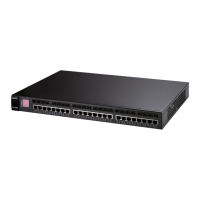
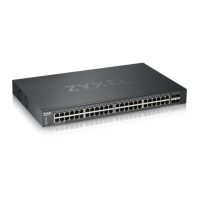
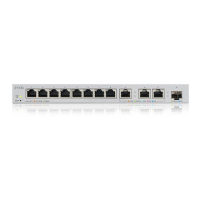
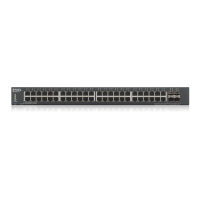



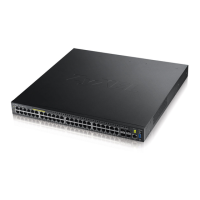
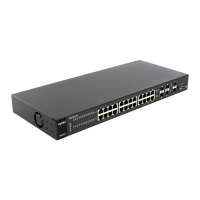

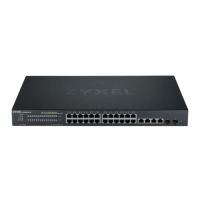
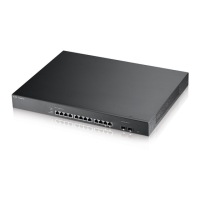
